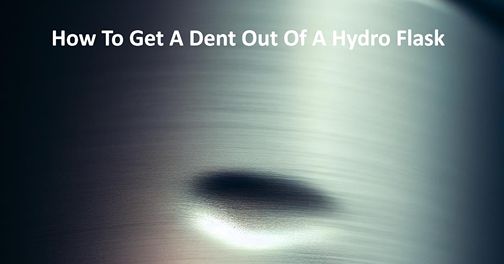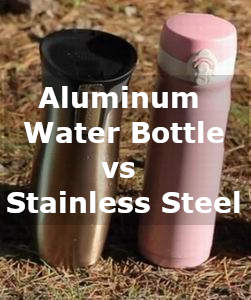
Wet flasks are essential components of our everyday lives, used for transporting water and other liquids. Although misuse or mishandling may lead to damage and dents that render the flask unusable, simple techniques are available for quickly repairing any underwater wings that have become dented or gap-toothed over time.
How to Fix a Dent in a Hydro Flask: Easy Techniques!
Before trying other methods to remove a dent, simple strategies such as heating and cooling should be employed first. If they don’t work, different techniques should be explored.
- Boiling Water: Bring water to a boil and immerse the pressurized section for several seconds in boiling water. Slowly pull it out, apply mechanical pressure, and reshape it as desired.
- Use a Hair Dryer: Heat the damaged area with a hot hair dryer before applying mechanical pressure to reshape it.
- With a Vacuum Pump: Apply a vacuum pump directly to the perforated area of a hydro bottle and suction until all dent is gone.
- Utilizing a steam generator: Heat hot steam, distribute it through perforations in the HydroBottle, and apply mechanical pressure to shape its form.
Replacing a dented can be done quickly by following this approach, but consider its precautions when applying this method. Safety must always come first, as some ways may prove harmful.
Are Effective Solutions To Fix Dents Quickly!
Wet snorkels are an indispensable tool for outdoor enthusiasts looking for intense entertainment or sports in nature. However, occasionally there can be unexpected incidents with hydro flasks being damaged – when this occurs, users must know how to resolve this problem efficiently and quickly.
- For quick and straightforward bottle depending, boiling water is your go-to solution. Pour hot water into a bottle, tightly close its lid, and allow it to sit for 10-15 minutes before gently using your hand or spoon to deform any dented areas.
- If hot water is unavailable, use a hair dryer instead. Set the hot water flask approximately 10 cm from the hair dryer, place it beneath, heat the dent until it becomes adaptable, and then smooth it by hand.
- If the dent is on an exposed sidewall of your flask or daylight-lit area, use a weight and rotate it several times inside to smooth out any cut or irregularity in its surface. The importance should help smooth out its rough surfaces.
If the dent is accessible, such as near the neck of your flask, turn up the rainbow power setting on your vacuum cleaner aid piece and fill in the print with the rainbow tip until it fills to restore its shape and form. This should help restore its original condition.
Learn these techniques, quickly eliminate undrained water and continue enjoying the thrills of outdoor living.
Hot Water If your pedal bike has small dents, consider using hot water. While straightforward, this solution may take longer to produce results than anticipated.
Step-by-Step Manual:
- Within your Erlenmeyer, hot water is filled to the brim. Once complete, remove from heat source.
- Heat the Erlenmeyer for several minutes to help soften and refine the metal into a more refined texture.
- Remove the Erlenmeyer from its water container and set it on a flat surface.
- Send a beam of cold water directly into the dent to quickly cool off any hot metal surfaces that have become overheated.
- Try gently pressing on the dent with a cloth or fingers for optimal results.
If a complex stream of water fails to eliminate a dent, additional warm water or extended immersion time in a warm water wave may help. Be wary that too hot an environment may damage either its coating or plastic properties – or both!
Heating of Jugs
One of the most straightforward techniques for removing dents is heating it at its base with hot water and leaving it to sit until all plastic surfaces have become smooth. You can straighten any dented areas or use pressed tools such as bottle collars.
If the Erlenmeyer is made of stainless steel, warm pebbles or heated sand may help smoothen out its flask by heating them on the stove before placing them onto it – leaving only minor dents and indents to remove later. After a few minutes, the flask will feel smoother, while any mark will be easier to remove.
Be mindful that overheating can damage and destroy the Hydro Flask itself, so do not heat it for too long or at too high a temperature.
Kinetic Pressure
Kinetic pressure is widely considered one of the most efficient techniques for eliminating hydrophobic dents, using a small device known as a pump to apply force against them.
- To successfully use this method, the appropriate solution must be selected.
- Use a pump with enough power to flatten out dent effectively.
- Apply the pump directly onto the dent and air into its hydrophobic interior.
- Continue pumping air until the dent has been leveled completely.
Note that this technique requires care and caution to protect the hydrophore. When appropriately applied, dent can be removed quickly and effortlessly from hydroholic.
Pump
This option involves using a compressor or pump. First, open the flask’s lid to access its dent, and connect your pump to the valve on the flask.
Use the pump and slowly start blowing on the flask until the dent is reduced. To prevent damage, do not pump too quickly or firmly; blow too hard and the walls could burst.
If you don’t own a compressor or pump, an alternative method might be using a vacuum cleaner with an accessory for blowing air out. But this process may take more time.
Safety glasses should always be worn when operating a pump or compressor to protect from potential malfunctions.
Once the dent has been repaired, reassemble your hydro flask by attaching its cap and verifying there are no leaks – your hydro flask should look brand new!
Applying Pressure
If the usual dent removal methods in pressurized water systems have failed, applying pressure may be the solution. To do this, follow these steps.
- Fill a flask to its maximum capacity with hot, boiling water.
- Carefully cork the triangular flask, making sure all edges are tightly shut.
- Cover your flask with soft material such as a clean towel to prevent accidental drops.
- Press all sides of the bottle from all angles, paying particular attention to any dents. Pressure should be adequate yet firm not to disrupt the pressurized water system in another chamber.
Repeat this operation until the pressurized water system returns to its initial form. Care should be taken to fill the hydro flask with enough water as that would end in disaster during the pressure application process.
Utilizing a Hair Dryer
To use this technique, apply hot air directly into the recesses of a hydro flask using an ordinary hair dryer that has been switched on while keeping at a distance of 10-15 cm from its plane to prevent overheating.
The heat from a hair dryer will stretch the fabric, softening any indentation more subtly. Make sure you move it around periodically to treat all hydrofoil surfaces simultaneously.
This technique can be advantageous when the pressurized water system features numerous dents or unusual shapes which cannot be quickly corrected using other techniques.
Create Hydroflag
Before removing dents from an Hydro Flask, proper preparation must be undertaken. This will guarantee optimal performance and faster recovery time.
With hot water and a soft sponge or piece, start by cleaning the surface of the hydro flug free of dirt, dust, food debris, and any other potential contaminants. Next, dry it thoroughly using a clean towel or cloth.
If tape or other sticky materials remain attached to a nonspherical surface, they should be removed with solvents or cleaning surfaces tailored for that task.
Before removing dents, the must be completely dry and clean to ensure optimal restoration performance.
Removal of Dent
1. Pour hot water into the sink and allow the flask to return to room temperature over several minutes – depending on its depth and duration.
2. Combine two vinegar and one part water in a bowl and allow this solution to sit in your bottle for 10-15 minutes.
Fill your vial with air until its consistency has changed significantly.
4. Consult a professional dent repairer. They have access to unique tools and techniques that will effectively remove dents from wings without further damaging the wings themselves. Be your security when choosing an expert in this field.
Utilizing Ice to Eliminate Dents
This method is particularly suitable for repairing minor dents. Ice is one of the more effective means dents, but only if they have recently been noticed.
An ice cube and bag are needed for this technique to work correctly. Place the cube inside the bag and allow it to chill before placing it over an indented area on your wing until both are cool enough. Remove it from the bag and cover your dent with it – leave it in place for 20-30 minutes so the dent can fully freeze over.
Remove ice from a hydrophobic surface and ensure it is nearly dent-free before proceeding with the function. If any dents do remain, repeat until desired results have been reached.
Carefully withdraw the bottle from the water, and wipe its surface using a smooth cloth or sponge. If there remains an indentation in its entirety, repeat this step for best results.
Note: Please ensure the ice remains for only a short time to prevent hydrome damage.
Removing Dents Using Rice
To remove a dent in the water supply, people often use all sorts of materials, including hot water and hair dryers. However, rice can also be used. This method is simple and effective; all you need is rice and a few pieces of water.
Then start by pouring a small amount of water onto the water flies, bringing them to about 50% of their size. Then add boiled rice to the water, for example, to fill the remaining free space. Usually 2 to 3 tablespoons is sufficient.
Close the cork in the water and shake well for a few minutes. The rice will gently slide along the underwater walls, removing the notches. After a long shake, the hydrohoa should regain its original form.
Shake the same way several more times to allow the erlenmeyer to fully recover. Next, using a sieve or heavy-duty sieve, remove the rice from the flask and rinse it with water. The flask should now look fresh and ready to use.
This method is suitable for many types of vacuum flask ranges, but be sure to follow the manufacturer’s instructions and that this method will not damage the hydro flask. In general, using rice to remove dents in the hydro flask is a fairly simple and effective method that has the potential to save time and money in repairs.
Q: What should I do if I have a dent in the water after a fall?
Answer: There are several simple techniques that can help you get a dent out of a wet bottle. For example, boiling water and ice.
Question: Which method is most effective?
Answer: Both methods are most effective on an individual level, but for the most permanent dents more than any other method, this method should be used with boiling water and ice.
Question: Can these methods be used on other iron objects?
Answer: Yes, these methods can be used to remove dents from other iron bottles, but before doing so, you must make sure that this method will not damage them.
Question: Can this method be used to split plastics?
Answer: No, because plastics can be destroyed by high temperatures and solvents.






